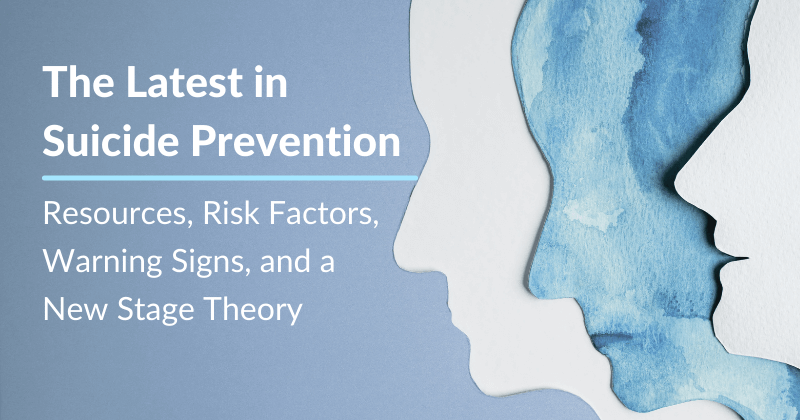The Latest in Suicide Prevention: Resources, Risk Factors, Warning Signs, and a New Stage Theory

[Editor’s Note: Every month, MCN’s Director of Witness to Witness, Kaethe Weingarten, PhD, shares stories, resources, and helpful tips to support health care workers during these ongoing unprecedented times. Here, Dr. Weingarten gets a head start on September’s Suicide Prevention Month with new resources and approaches to support people considering suicide. Dr. Weingarten also offers a twice-monthly newsletter, filled with resources, recent articles, and her news and views. Sign up for the newsletter and grab bilingual resources on the Witness to Witness webpage.]
It is a sign of significant progress that we now have a dedicated number to call in case of mental health crises. People experiencing a mental health crisis can call or text the numbers 9-8-8. The number connects people to a trained mental health professional.
The need for this service is great and growing. The national statistics on suicide are alarming, but when you consider the impact on the network of loved ones and others who are impacted by every known suicide attempt and completion, the numbers are truly overwhelming. Convert those numbers to stories and memories of people who were loved but felt lost, and it is a very sad situation indeed.
Recent estimates suggest a 30% increase in death by suicide from 1996-2016, with alarming increases in suicide rates for children and BIPOC children in particular. (See Six Practical Steps to Prevent Child Suicide, from last year.) Despite horrific mass shootings that garnered significant national attention, the gun legislation that passed at the Federal level in June is still weak: 18-year-olds can still buy automatic weapons. There is evidence that suicide by firearms has increased in the last 20 years for children from ages one to 19. If the US childhood suicide rate was the same as in other peer countries of the US, 1,100 fewer children would have died in 2020. It is tragic when anyone dies by suicide let alone a child. Typically, they leave a large group of people, especially other children, wondering why it happened and what they might have done to prevent it. A friend’s suicide can haunt a person for a lifetime.
In this handout, I provide some tips for what to look out for, a recently developed framework to understand what precipitates a suicide, and some questions that a friend or family member might ask someone they fear might harm themselves.
There are risk factors that provide the backdrop for many people who complete a suicide. The presence of risk factors cannot predict who will attempt suicide.
Here are some known risk factors:
- Alcohol and substance abuse disorders
- Serious mental illness
- Impulsive temperament
- History of trauma or abuse
- Family history of suicide
- Recent losses, of a job or a relationship
- Recent legal or financial difficulties
- Previous suicide attempts
- Access to means
- Recent community cluster of suicides
- Stigma to help-seeking behavior
- Social isolation and lack of social support
- Little or no access to mental health or health care services
The warning signs of someone being actively suicidal fall into three categories: mood, talk, and behavior.
Mood:
- Depressed
- Anxious
- Irritability
- Agitation/anger
- Sudden relief and release from prior down mood
Talk:
If a person talks about:
- Feeling worthless or useless
- Feeling trapped
- Feeling that they are a burden to others
- Wanting relief from unbearable pain
- Saying they want to kill themselves
- Having lost all reasons to live
- Feeling hopeless
Behavior:
- Increased use of alcohol or drugs
- Searching for methods of suicide online
- Withdrawing from previous activities
- Isolating from family and friends
- Skipping school
- Giving away possessions
- Calling people to say good-bye
- Lethargy
- Heightened aggression
- Reckless Behavior
Framework:
Recent research on those who contemplate and then attempt or complete suicide has led to a stage theory of how suicide occurs. The Narrative Crisis Model of Suicide proposes that certain trait characteristics like impulsivity make a person more vulnerable to suicide. Other characteristics have to do with how the person coped with a childhood in which their needs were not well met. Some people whose childhoods were filled with abuse and neglect have more trouble navigating the ups and downs of life. The next stage in the model is that the person develops a narrative in which they can see no positive way forward for themselves. They often feel defeated, burdensome to others, humiliated, and thwarted from all of their life goals.
The next stage is termed the Suicide Crisis Syndrome. At this stage, the person feels trapped with no options and no way out of their life circumstances. They are in unbearable emotional pain and they ruminate on the circumstances they believe have led them to feel this way, blaming themselves and others. They may feel a great deal of panic at this stage that is so overwhelming that they dissociate from it. Paradoxically, although they may later go on to attempt suicide, at this stage, it is hypothesized, they actually fear death. It is only after this stage that the person takes action toward suicide. Their thought of doing so may have only occurred briefly, just before they make their attempt. In other words, asking someone if they are suicidal may not be as useful a question as asking someone if they feel trapped.
If you are in a position or role that it is appropriate for you to approach someone you think may be suicidal, there are a few gentle questions you might want to start with to see if the person might open up to you.
“I can tell something is bothering you. Do you want to talk about it with me or someone else?”
“You don’t seem to be yourself these days. I’d really like to hear how you are feeling.”
If the person does open up to you, it’s helpful to try to get them to tell their experience as if they are telling you a story. As they talk, you may note whether they seem to have developed a suicide narrative or have entered the stage of the Suicidal Crisis Syndrome. If so, these are a few questions that may help you learn what is going on for them.
- You seem to feel there is no solution to your current problems. Is that how you are feeling now?
- Are you feeling that you cannot escape your problems?
- Do things feel unreal to you?
- Are you having physical sensations that are odd and hard to describe?
- Are you feeling like you cannot turn off your thoughts and you really want to?
- Have you been having fears that something truly bad might happen to you?
- Have you been feeling emotional pain that is so intense it’s unbearable?
- Do you want to do anything to stop the unbearable pain you feel?
You don’t have to figure this out yourself. You can talk over your concerns with other people. Youth may want to talk to a parent or a teacher. Adults may choose someone whose opinions they respect. Clinicians, including outreach workers and Community Health Workers, can bring in the care team or a trusted health care provider. Together you can make a decision about how to get the person the help they need.
You can start by suggesting the person use one of the many resources that are available. Here are a few. If the person refuses, you can call these resources yourself and get help with next steps.
Here are a few resources:
Suicide Prevention Facts & Resources, from the Substance Abuse and Mental Health Services Administration
Digital Shareables on Suicide Prevention, from the National Institute of Mental Health
Risk of Suicide, from the National Alliance on Mental Illness
Speaking of Suicide, a website of resources exclusively on suicide
988 Suicide & Crisis Lifeline, the website that accompanies the 9-8-8 crisis number, has numerous resources including some in Spanish
Often states and cities have their own local suicide prevention resource packet available online. Use a search engine and type in “suicide prevention resources” and the name of your city, county, or state.
Additional References:
https://suicidepreventionlifeline.org/how-we-can-all-prevent-suicide/
http://jessespaddle.org/warningsigns.html
Galynker, I., Yaseen, Z. S., Cohen, A., Benhamou, O., Hawes, M., & Briggs, J. (2017). Prediction of suicidal behavior in high risk psychiatric patients using an assessment of acute suicidal state: The suicide crisis inventory. Depression and anxiety, 34(2), 147–158. https://doi.org/10.1002/da.22559
- Log in to post comments
